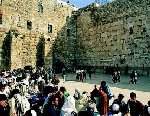 Jerusalem, situated in the Judean Hills, is the capital of Israel, the seat of government and the historical, spiritual and national center of
the Jewish people since King David made it the capital of the Kingdom of Israel some 3,000 years ago. Sanctified by religion and tradition, by holy
places and houses of worship, Jerusalem was a walled city until 1860. At that time, the Jews, who by then comprised the majority of its population, began to establish new neighborhoods outside the walls, forming the nucleus of modern Jerusalem.
During four decades of British administration (1918-48), the city
gradually changed from a neglected provincial town of the Ottoman Empire
(1518-1918) into a flourishing metropolis, with many new residential
neighborhoods, each reflecting the character of the particular group
living there. Following the Arab onslaught against the newly established
Jerusalem, situated in the Judean Hills, is the capital of Israel, the seat of government and the historical, spiritual and national center of
the Jewish people since King David made it the capital of the Kingdom of Israel some 3,000 years ago. Sanctified by religion and tradition, by holy
places and houses of worship, Jerusalem was a walled city until 1860. At that time, the Jews, who by then comprised the majority of its population, began to establish new neighborhoods outside the walls, forming the nucleus of modern Jerusalem.
During four decades of British administration (1918-48), the city
gradually changed from a neglected provincial town of the Ottoman Empire
(1518-1918) into a flourishing metropolis, with many new residential
neighborhoods, each reflecting the character of the particular group
living there. Following the Arab onslaught against the newly established
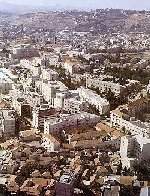 State of Israel, the city was divided (1949) under Israeli and Jordanian
rule, and for the next 19 years concrete walls and barbed wire sealed off
one part from the other. As a result of the assault on Jerusalem in the
1967 Six-Day War, the city was reunified.
State of Israel, the city was divided (1949) under Israeli and Jordanian
rule, and for the next 19 years concrete walls and barbed wire sealed off
one part from the other. As a result of the assault on Jerusalem in the
1967 Six-Day War, the city was reunified.
Today Israel's largest city, Jerusalem has a population of over 600,000. At once ancient and modern, it is a city of diversity, with inhabitants representing a mixture of cultures and nationalities, of religiously observant and secular lifestyles. It is a city which preserves its past and builds for the future, with carefully restored historical sites, well-landscaped green areas, modern commercial zones, industrial parks and expanding suburbs attesting to its continuity and vitality.
Hebron is a holy city for the Jewish People in the Land of Israel, second only to Jerusalem. Here King David reigned for 7 years before moving to Jerusalem. The Jewish Patriarchs are burried here, in the Cave of
 Machpela. Through the centuries, Hebron and the Cave of Machpela continued to be the focus of the yearnings of the Jewish People. Despite the perils of the journey and the hardships they incurred, Jews continued to make the trek to the City of their Forefathers. To travelers to the Holy Land, Hebron and the Cave of the Machpela were always important sites. Reb Benjamin of Tudelah writes about it during his trip to Hebron in 1173: "And in the valley is the Cave of Machpela, if a Jew should pay the Ishmaelite watchman, he will open for him an iron gate. From there one descends stairs with a candle in hand. Upon reaching the third cave one will find six graves. These are the graves of Abraham, Isaac and Jacob, and opposite them, Sarah, Rebecca and Leah."
Machpela. Through the centuries, Hebron and the Cave of Machpela continued to be the focus of the yearnings of the Jewish People. Despite the perils of the journey and the hardships they incurred, Jews continued to make the trek to the City of their Forefathers. To travelers to the Holy Land, Hebron and the Cave of the Machpela were always important sites. Reb Benjamin of Tudelah writes about it during his trip to Hebron in 1173: "And in the valley is the Cave of Machpela, if a Jew should pay the Ishmaelite watchman, he will open for him an iron gate. From there one descends stairs with a candle in hand. Upon reaching the third cave one will find six graves. These are the graves of Abraham, Isaac and Jacob, and opposite them, Sarah, Rebecca and Leah."
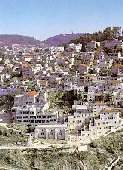 Safed is considered the third holy city for the Jews in the Land of Israel. Perched high in the mountains of Galilee, Safed is a popular summer
resort and tourist site, with an artists' quarter and several
centuries-old synagogues. In the 16th century, Safed was the most
important center of Jewish learning and creativity in the world - the
gathering place of rabbis, scholars and mystics who laid down religious
laws and precepts, such as the Kabbala.
Safed is considered the third holy city for the Jews in the Land of Israel. Perched high in the mountains of Galilee, Safed is a popular summer
resort and tourist site, with an artists' quarter and several
centuries-old synagogues. In the 16th century, Safed was the most
important center of Jewish learning and creativity in the world - the
gathering place of rabbis, scholars and mystics who laid down religious
laws and precepts, such as the Kabbala.
 Tiberias is considered the fourth holy city for the Jews in the Land of Israel. Located on the shore of Lake Kinneret, Tiberias is famous for its therapeutic hot springs. Today the town is a bustling lakeside tourist center, where archeological remains of the past blend with modern houses and hotels. Founded in the 1st century and named for the Roman Emperor Tiberius, it became a center of Jewish scholarship and the site of a well-known
rabbinical academy.
Tiberias is considered the fourth holy city for the Jews in the Land of Israel. Located on the shore of Lake Kinneret, Tiberias is famous for its therapeutic hot springs. Today the town is a bustling lakeside tourist center, where archeological remains of the past blend with modern houses and hotels. Founded in the 1st century and named for the Roman Emperor Tiberius, it became a center of Jewish scholarship and the site of a well-known
rabbinical academy.
 Tel Aviv, a modern city on the Mediterranean coast, is Israel's
commercial and financial center. Headquartered there are most industrial and agricultural organizations, as well as the stock exchange. Tel Aviv, the first all-Jewish city in modern times, was founded in 1909 as a suburb of Jaffa, one of the oldest urban settlements in the world.
Tel Aviv, a modern city on the Mediterranean coast, is Israel's
commercial and financial center. Headquartered there are most industrial and agricultural organizations, as well as the stock exchange. Tel Aviv, the first all-Jewish city in modern times, was founded in 1909 as a suburb of Jaffa, one of the oldest urban settlements in the world.
Haifa, on the Mediterranean Sea, rises from the coastline over the slopes of Mount Carmel. It is built on three topographical levels: the lower
city, partly on land recovered from the sea, is the commercial center with
 harbor facilities; the middle level is an older residential area; and the
top level consists of rapidly expanding modern neighborhoods with
tree-lined streets, parks and pine woods, overlooking the industrial zones
and sandy beaches on the shore of the wide bay below. A major deep-water
port, Haifa is a focus of international trade and commerce. It also serves
as the administrative center of northern Israel.
harbor facilities; the middle level is an older residential area; and the
top level consists of rapidly expanding modern neighborhoods with
tree-lined streets, parks and pine woods, overlooking the industrial zones
and sandy beaches on the shore of the wide bay below. A major deep-water
port, Haifa is a focus of international trade and commerce. It also serves
as the administrative center of northern Israel.
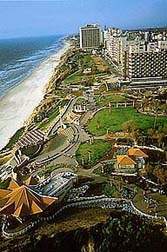 Netanya is located close to the seashores of the Mediteranean Sea.
Netanya's proximity to the sea and its pleasant climate have made the city a most desirable tourist attraction and resort area. Netanya, the largest city on the crossroads between Tel-Aviv and Haifa forms a connecting link between the northern and central parts of the country. Due to its central location near the Tel-Aviv - Haifa railroad tracks, Netanya has become a center for industrial development. Nearby services provide a wide variety of activities from nature walks for the whole family to sports such as paragliding and sail boating.
Netanya is located close to the seashores of the Mediteranean Sea.
Netanya's proximity to the sea and its pleasant climate have made the city a most desirable tourist attraction and resort area. Netanya, the largest city on the crossroads between Tel-Aviv and Haifa forms a connecting link between the northern and central parts of the country. Due to its central location near the Tel-Aviv - Haifa railroad tracks, Netanya has become a center for industrial development. Nearby services provide a wide variety of activities from nature walks for the whole family to sports such as paragliding and sail boating.
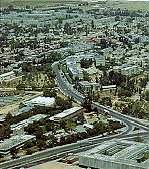 Be'er Sheva, in the northern Negev, is located at the intersection of
routes leading to the Dead Sea and Eilat. It is a new city built on an
ancient site, dating back to the age of the Patriarchs some 3,500 years
ago. Called the "Capital of the Negev," Be'er Sheva is an administrative
and economic center, with regional government offices and institutions of
health, education and culture which serve all of southern Israel.
Be'er Sheva, in the northern Negev, is located at the intersection of
routes leading to the Dead Sea and Eilat. It is a new city built on an
ancient site, dating back to the age of the Patriarchs some 3,500 years
ago. Called the "Capital of the Negev," Be'er Sheva is an administrative
and economic center, with regional government offices and institutions of
health, education and culture which serve all of southern Israel.
Eilat the country's southernmost city, is Israel's outlet to the Red Sea and the Indian Ocean. Its modern port, believed to be located on the 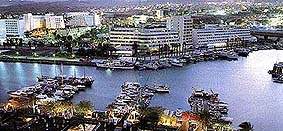 site of a harbor used in the time of King Solomon, handles Israel's trade
with Africa and the Far East. Warm winters, spectacular underwater scenery,
well appointed beaches, water sports, luxury hotels and accessibility from
Europe via direct charter flights have made Eilat a thriving, year-round
tourist resort.
site of a harbor used in the time of King Solomon, handles Israel's trade
with Africa and the Far East. Warm winters, spectacular underwater scenery,
well appointed beaches, water sports, luxury hotels and accessibility from
Europe via direct charter flights have made Eilat a thriving, year-round
tourist resort.
Copyright © 1995 - 2025 Ahavat Israel. All rights reserved.